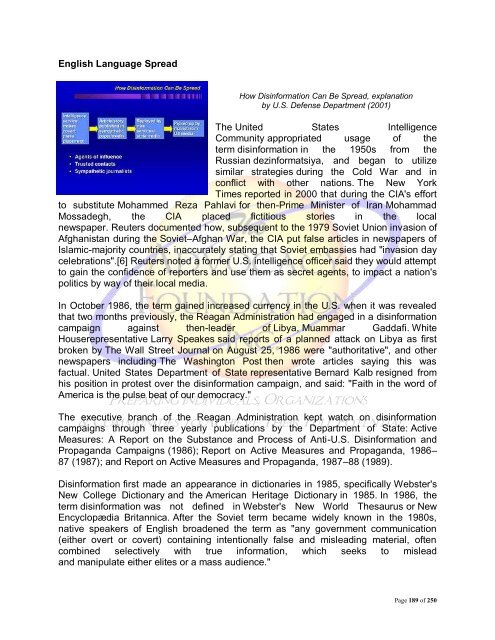Institutional Racism
Institutional Racism
Institutional Racism
Create successful ePaper yourself
Turn your PDF publications into a flip-book with our unique Google optimized e-Paper software.
English Language Spread<br />
How Disinformation Can Be Spread, explanation<br />
by U.S. Defense Department (2001)<br />
The United States Intelligence<br />
Community appropriated usage of the<br />
term disinformation in the 1950s from the<br />
Russian dezinformatsiya, and began to utilize<br />
similar strategies during the Cold War and in<br />
conflict with other nations. The New York<br />
Times reported in 2000 that during the CIA's effort<br />
to substitute Mohammed Reza Pahlavi for then-Prime Minister of Iran Mohammad<br />
Mossadegh, the CIA placed fictitious stories in the local<br />
newspaper. Reuters documented how, subsequent to the 1979 Soviet Union invasion of<br />
Afghanistan during the Soviet–Afghan War, the CIA put false articles in newspapers of<br />
Islamic-majority countries, inaccurately stating that Soviet embassies had "invasion day<br />
celebrations".[6] Reuters noted a former U.S. intelligence officer said they would attempt<br />
to gain the confidence of reporters and use them as secret agents, to impact a nation's<br />
politics by way of their local media.<br />
In October 1986, the term gained increased currency in the U.S. when it was revealed<br />
that two months previously, the Reagan Administration had engaged in a disinformation<br />
campaign against then-leader of Libya, Muammar Gaddafi. White<br />
Houserepresentative Larry Speakes said reports of a planned attack on Libya as first<br />
broken by The Wall Street Journal on August 25, 1986 were "authoritative", and other<br />
newspapers including The Washington Post then wrote articles saying this was<br />
factual. United States Department of State representative Bernard Kalb resigned from<br />
his position in protest over the disinformation campaign, and said: "Faith in the word of<br />
America is the pulse beat of our democracy."<br />
The executive branch of the Reagan Administration kept watch on disinformation<br />
campaigns through three yearly publications by the Department of State: Active<br />
Measures: A Report on the Substance and Process of Anti-U.S. Disinformation and<br />
Propaganda Campaigns (1986); Report on Active Measures and Propaganda, 1986–<br />
87 (1987); and Report on Active Measures and Propaganda, 1987–88 (1989).<br />
Disinformation first made an appearance in dictionaries in 1985, specifically Webster's<br />
New College Dictionary and the American Heritage Dictionary in 1985. In 1986, the<br />
term disinformation was not defined in Webster's New World Thesaurus or New<br />
Encyclopædia Britannica. After the Soviet term became widely known in the 1980s,<br />
native speakers of English broadened the term as "any government communication<br />
(either overt or covert) containing intentionally false and misleading material, often<br />
combined selectively with true information, which seeks to mislead<br />
and manipulate either elites or a mass audience."<br />
Page 189 of 250

















